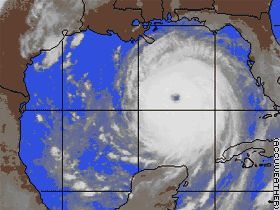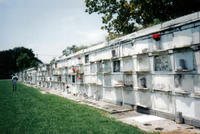
The NOAA website maps have it that Katrina, a Category 5 hurricane, is headed for southeast Louisiana, and may strike New Orleans. The thread is sufficiently dire that the government is encouraging has ordered mandatory evacuation, and has turned all lanes of the Interstates in an outbound direction.
A. J. Liebling called New Orleans as more a Caribbean island than part of the mainland, and although concrete causeways cross the swamps and Lake Ponchartrain, so one need not take a boat or a plane to get to the Big Easy, there is truth in Liebling's picture.
In fact, New Orleans is more a bowl than an island. The entire city is below sea level, and is sheltered from the waters of the Mississippi by enormous levees, the only slopes in the area, other than an artificial hill built for the benefit of children's play in one of the parks. Heavy rain being frequent, the city is kept dry by enormous Dutch-built pumps,
 while the dead
while the dead are protected from flooding, stored as some are in raised sepulchers.
are protected from flooding, stored as some are in raised sepulchers.
The comprehensive pattern of levees has caused the Mississippi delta east and south of New Orleans to shrink, because it has prevented the fanning out of the sediment-laden waters. Thus what the levees give in protection, to some extent they take away.
If the storm hits slightly west of the city, or lingers over it, dropping huge quantities of rain, or sends a 25-foot storm surge up the river, there is a real danger that the bowl will flood, and then the levees that kept the water out will keep the rain and flood waters in. The city would be flooded by waters full of the wastes of the entire Mississippi Valley, and its own sewage and other detritus. The giant pumps, without power and totally immersed, would go silent, and radical measures, such as breaching the levees above the river's water level, would be required. It might take months and years to pump the city out, repair its infrastructure, dry out, repair and replace its buildings.
Meanwhile, the economy, which depends upon tourism and the Port of New Orleans, and hasn't been robust for decades, would founder.
The “sociology of disaster” is an arcane academic field. One of its findings is that there is an almost irresistible urge in disaster-struck places to rebuild what had been there before, rather than either learning from the disaster to avoid future risks, or to take advantage of the devastation to build something more efficient and lovelier.
One exception in recent years has been a policy of discouraging the rebuilding of river's-edge towns along flooded areas of the Midwest, in favor of rebuilding them on higher ground. This policy has not been followed in the case of construction on low-lying Atlantic barrier islands, which periodically are damaged or demolished by storms, and benefit from low-cost federal loans for reconstruction.
New Orleans, for all its legendary seediness and long-depressed economy, is a national treasure, possessing a unique culture that has contributed much, especially to our musical tradition.
If the worst happens, the country clearly has the resources, between private insurance and federal funds, to rebuild the city. Given the need for a port somewhere near the mouth of the Mississippi, there is little doubt that New Orleans would be rebuilt, although how and to what extent remains in doubt. The natural impulse, says the sociology of disaster, will be to replace what was there as closely as possible. Whether the natural impulse is sensible policy is another question.

Had it not been for the work of the Army Corps of Engineers, the Mississippi river would probably no longer flow so far east, and would instead reach the Gulf to the west, in the Atchafalaya region, as it has in the past. New Orleans would be isolated on what would become a sluggish bayou, and no doubt one or more new port cities, lacking New Orleans's history and seedy charm, would arise.
If global warming is real, and is not reversed by some unpredictable event such as the collapse of Arctic sea ice diverting the Gulf Stream south, we may face these issues the world over. Shall we use Dutch techniques, massive levees and pumps, to protect low-lying cities, farms and atolls, or shall we accept certain changes and relocate populations to higher ground? And if so, at whose expense?
Meanwhile, we can hope and pray that New Orleans, a city that has been extraordinarily lucky in the face of hurricanes, skates out of danger once again, and Katrina pounds and floods relatively unpopulated areas.
We shall see.

No comments:
Post a Comment